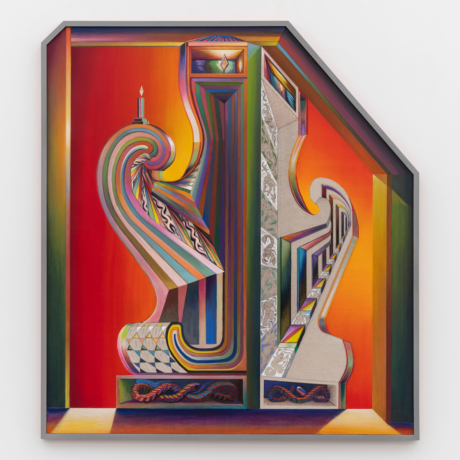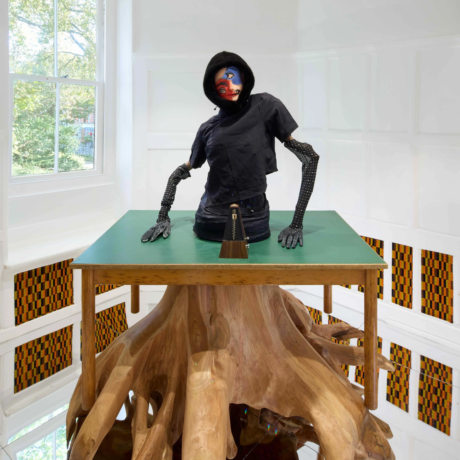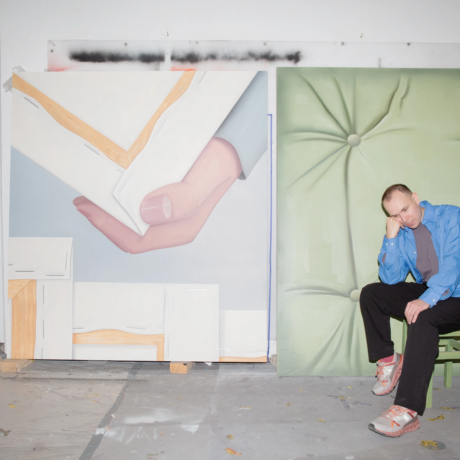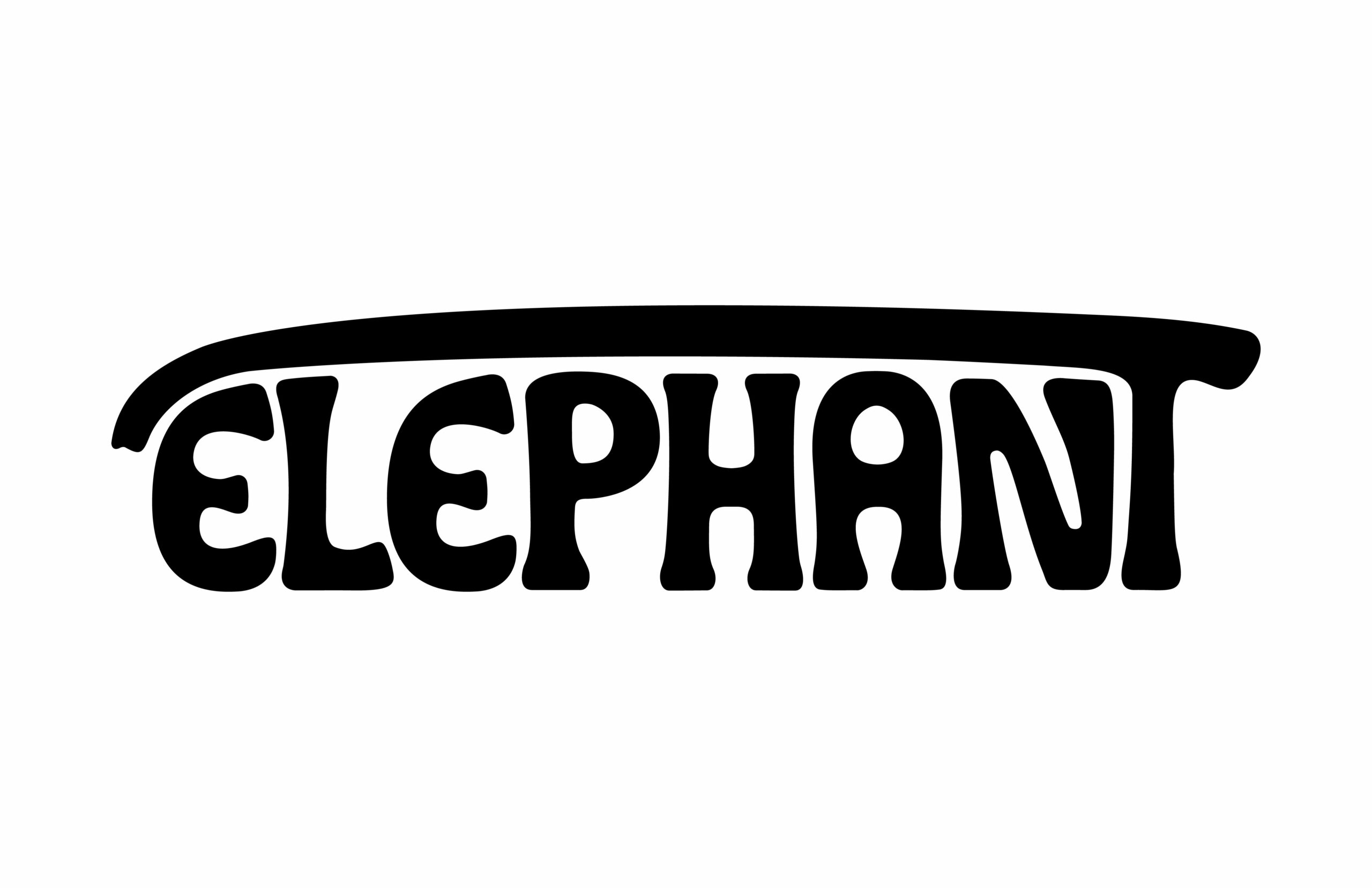Elephant’s associate editor Emily Burke speaks with Raven Halfmoon and Gisela McDaniel about their shared commitment to storytelling.
Looking at Raven Halfmoon and Gisela McDaniel’s work side by side, you might not immediately recognise the common thread running between their practices. Gisela’s paintings are lush and colourful, glistening with neon hues and the jewellery pieces punctured into the canvas, while Raven’s work is pared-back, minimally sculpted from earthen clays and glazed only, if at all, with blacks and reds after the native Red River clay and the Oklahoma soil. While each artist has a unique aesthetic language, they share a belief in art’s ability to amplify the voices of those whose stories are at risk of being erased.
Gisela McDaniel is an American artist of Indigenous Chamorro descent whose process is almost as sensitive as the outcome of her work. Before painting, McDaniel engages her subjects in a series of intimate questions and records their responses. These recordings are later played alongside the works wherever they’re shown.
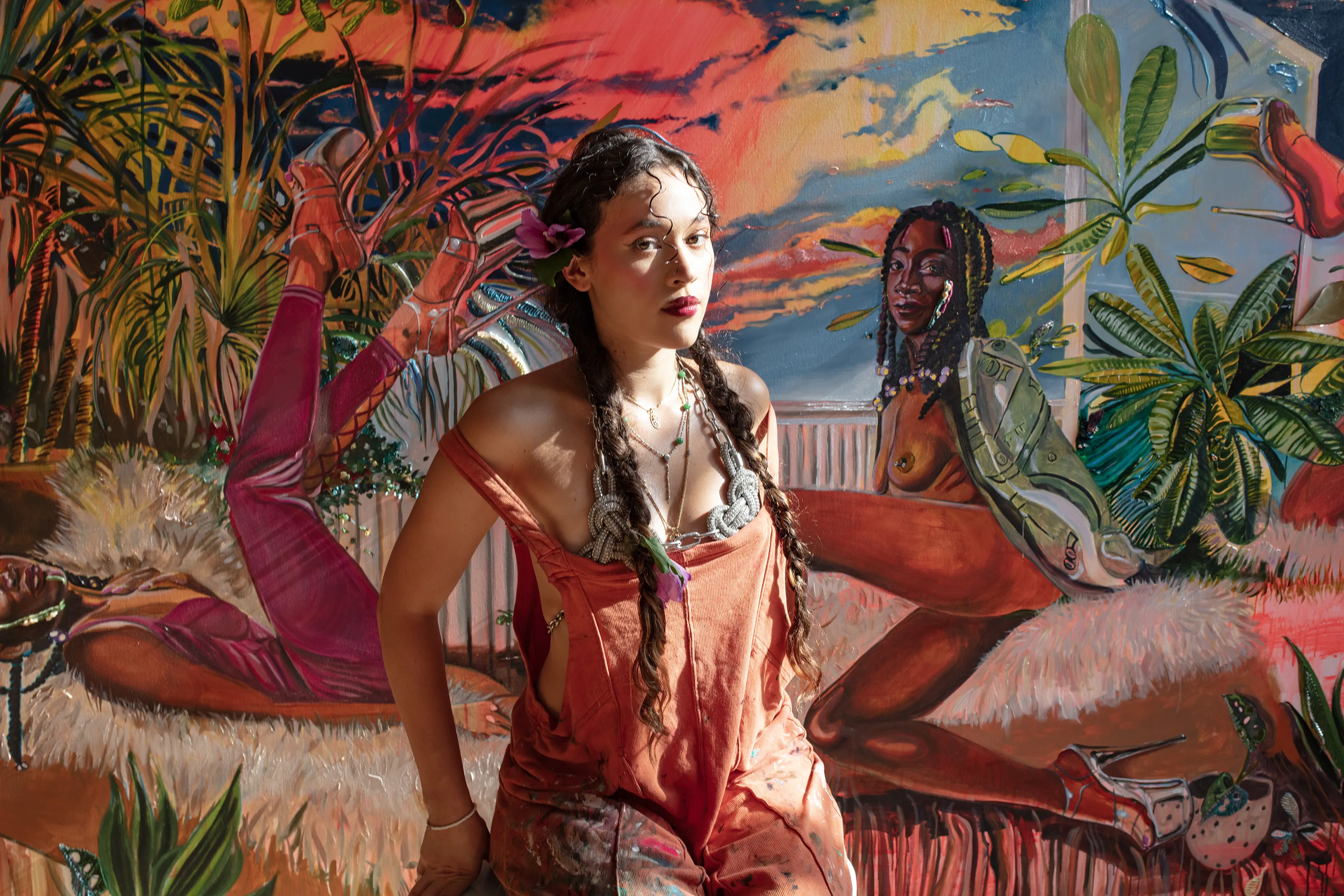
Raven Halfmoon is a painter and sculptor from the Caddo Nation. Her work incorporates traditional Caddo pottery techniques, which she uses to craft life-size figures that assert an enduring Indigenous presence.
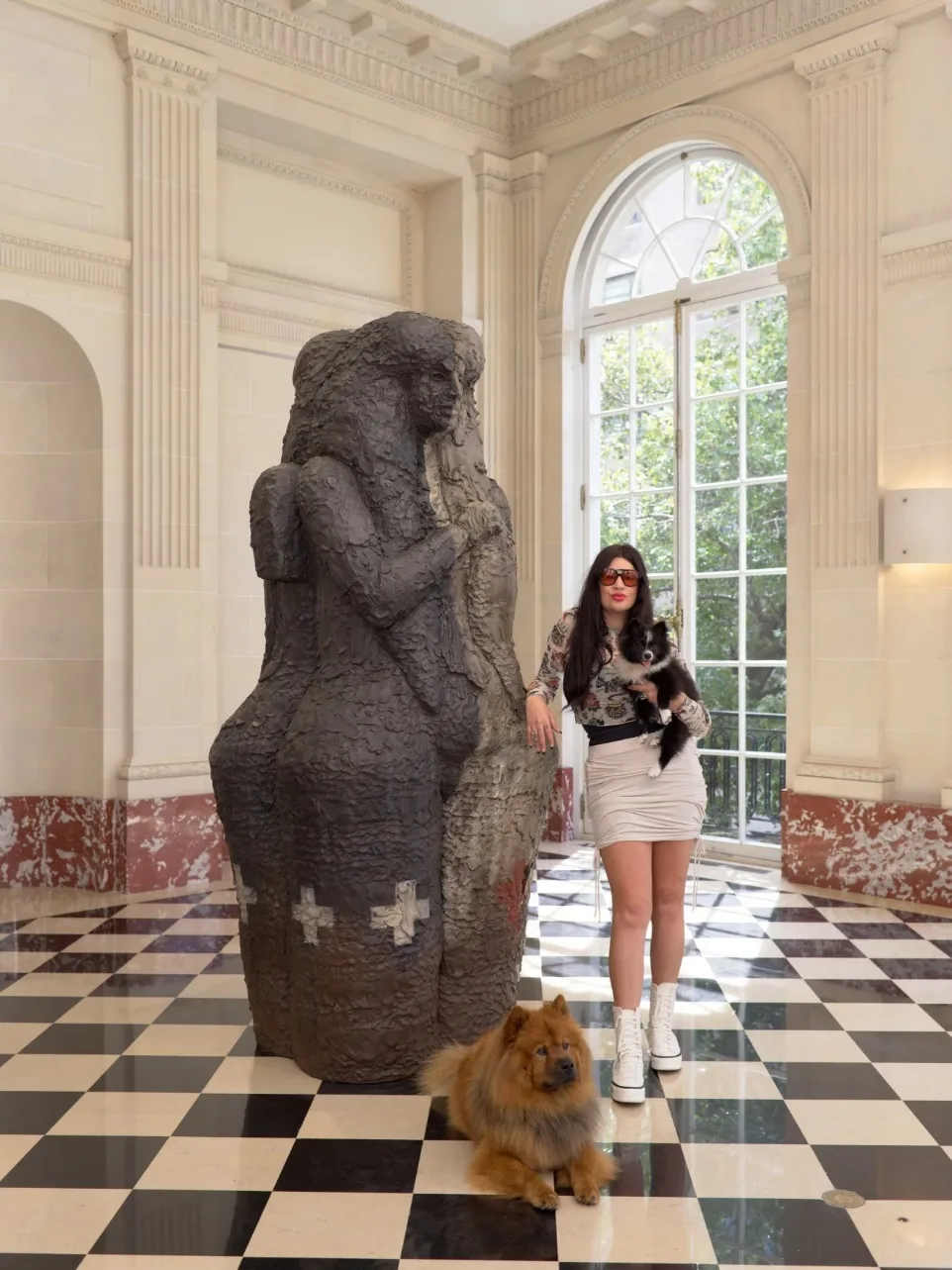
Their conversation spans the importance of storytelling in their native cultures and artistic practices, the multifaceted impact of art on their communities, and the meaningful legacy they wish to leave for generations to come.
Emily Burke: I’d like to start by asking about the importance of storytelling in both of your practices. Could you each share a bit about the stories that you’re trying to hold onto and share in your work?
Raven Halfmoon: From the stories told by my mother, grandmother, aunties and uncles to our tribe’s origin story, there are so many stories that have been passed down to me through generations of Caddo people which have shaped me as a person and the work that I create. So, in the work, I’m holding onto the experiences of my family, the stories that have been passed down, and my own lived experience. It’s all of these viewpoints mixed together.
Gisela McDaniel: I am really looking to record stories of healing. When we hear about stories of violence, we often focus on the violence itself, but I want to think about the wisdom that comes through these stories. I reflect a lot on my own ancestors and how they sailed the ocean with nothing but the stars, and I think a lot about the notion of talk-story, which is the practice of knowledge being shared through word of mouth from one generation to the next. I think about aunties gossiping and the wisdoms that keep us safe. Ultimately, I’m more interested in the stories that aren’t taught in schools, in the ones being told in breakfast nooks.
RH: I actually have a question for you, Gisela: do you work with live subject matters?
GM: I work from photos. But these photos are taken after I sit with the subject, talk to them, and we exchange stories. I then photograph them. From there, they choose a photo, and I work from that. It’s a really precious moment.
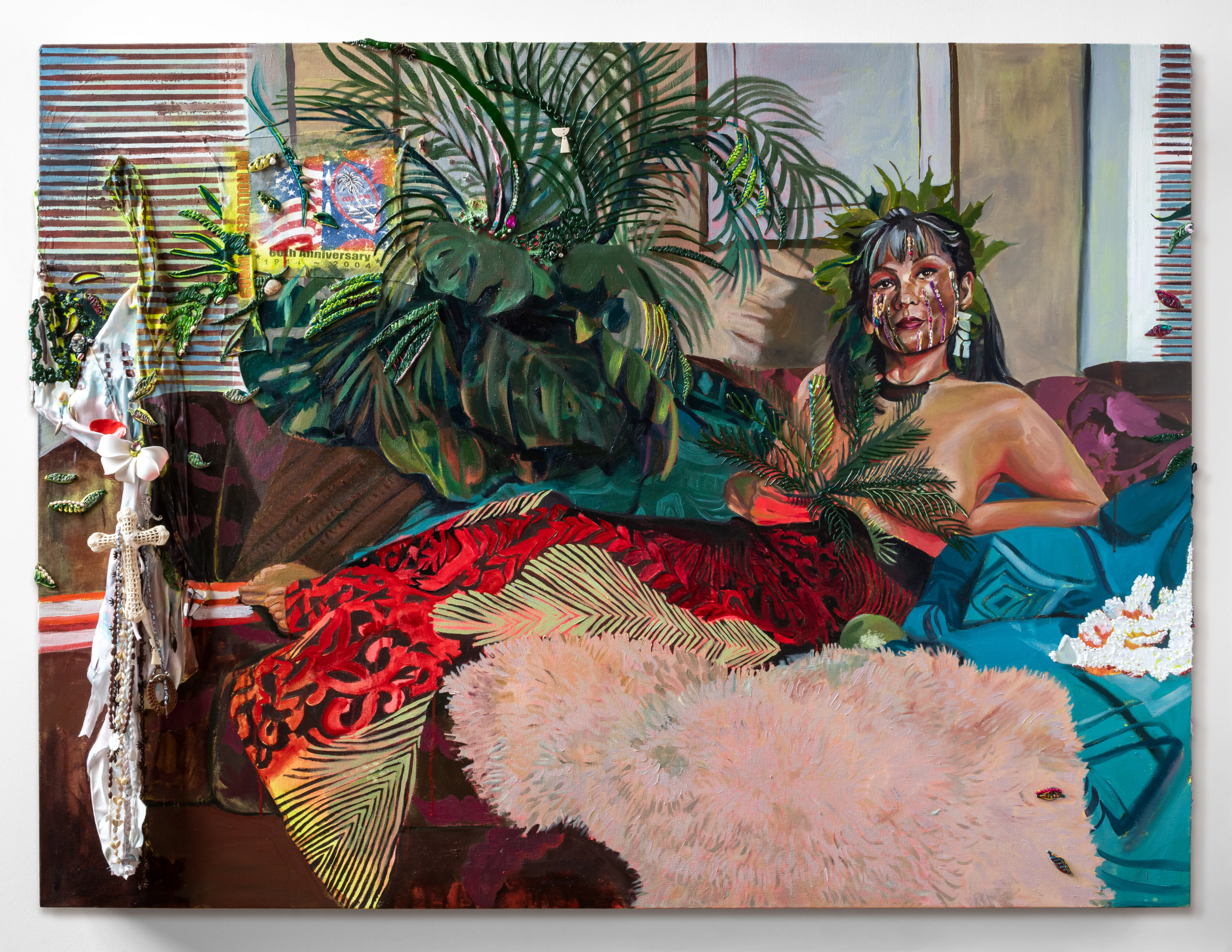
RH: That’s so cool. How are you finding these people?
GM: Initially, I was finding people at parties in Detroit, Michigan. But now, in New York, I put out pull-tab flyers or put out feelers on social media.
RH: And what do these conversations entail? Are you interviewing them? I love that idea of having an intimate moment with someone before photographing them.
GM: I send them questions beforehand. The questions include: what story do you want to be remembered by? What story do you carry with you? What are you proud of yourself for? What would you like to say to someone looking at you right now? Then I ask them how these stories shape the way they navigate the world.
EB: Why is storytelling so vital?
RH: Storytelling has always been how Caddo people pass down information from one generation to the next. It’s similar in a lot of native cultures. Storytelling is how we learn about the world—it’s how we learn about right and wrong. I love seeing the ceramics that my ancestors made centuries ago, and I believe that storytelling allows people to see how you view the world; it allows people to view the world through your eyes later on.
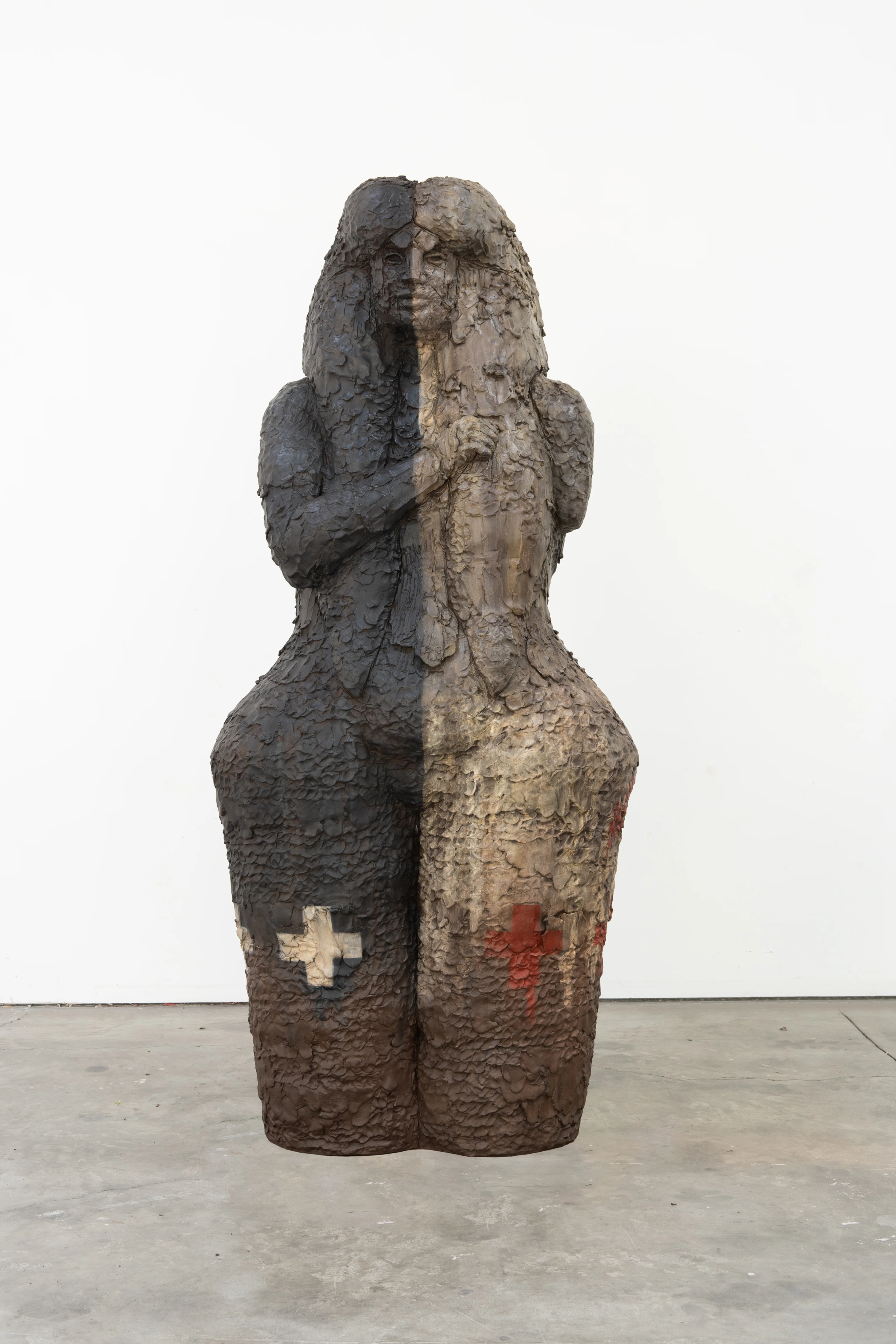
GM: I am really interested in telling the stories of femme people in art. When we look back through art history, we so rarely know who the women posing are or what their stories might have been. It’s a form of erasure. Storytelling allows us to keep that knowledge of women’s lives. As an artist, it’s exciting to be able to prioritise the people whose values we would like to share with the world.
EB: I wanted to ask about your relationships with your respective ancestries, because these come up a lot in your work. Do you feel that your art practice has enabled you to feel closer to your ancestors?
RH: I am very lucky because I’ve grown up around my tribe, so it has been pretty inherent for me to be part of that tribe and know my culture. But through making, I’ve grown a closeness in materiality to my ancestors. In museums, we see these artefacts made by ancestors, and so I went with an elder and made a traditional Caddo pot with clay pulled from the Red River, which was then pit-fired. It gave me insight into how my ancestors made things. I feel proud of the work I make, try to be respectful in everything I do, and definitely feel close to my ancestors.
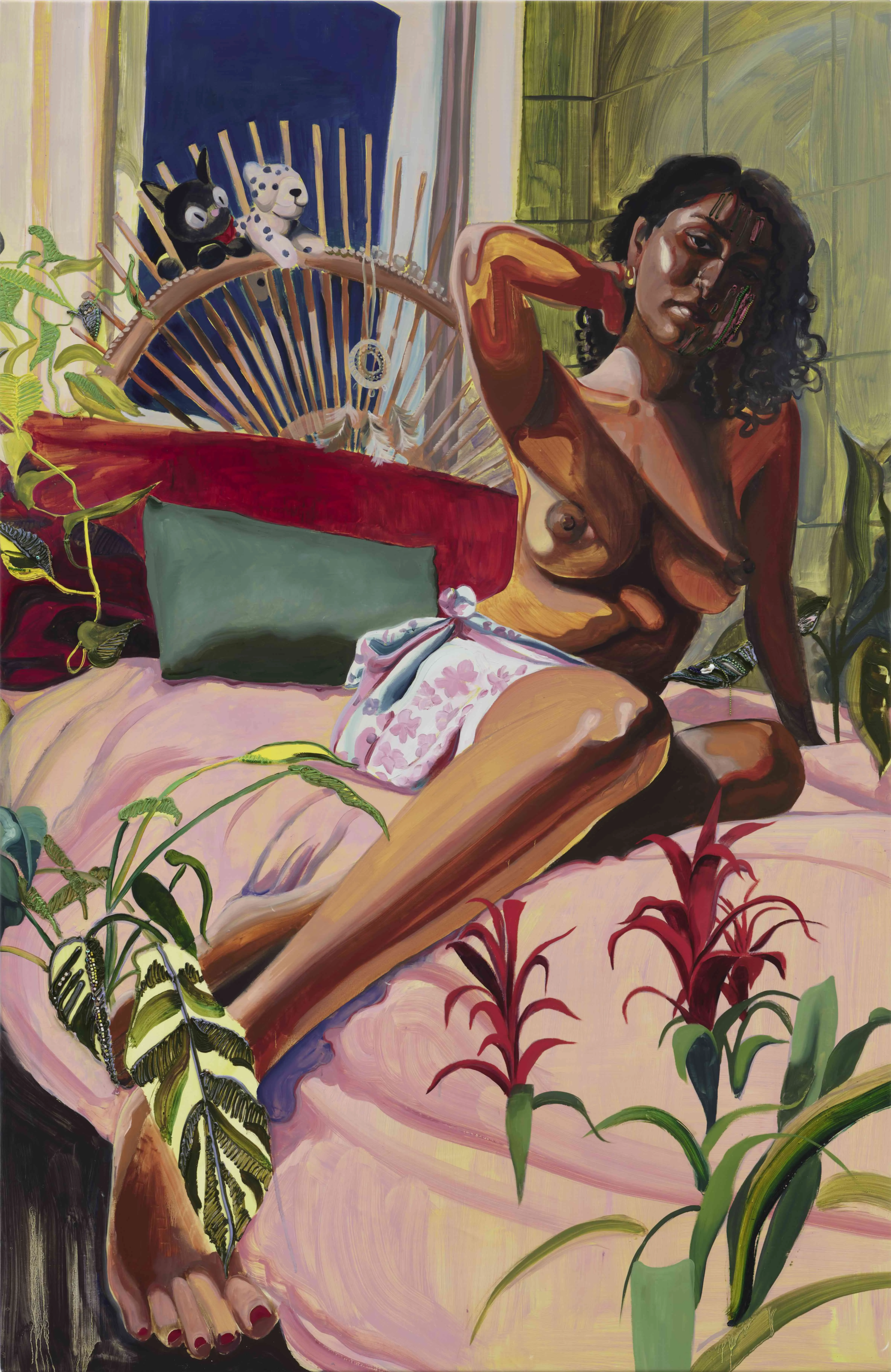
GM: I’ve been doing a project recently with traditional healers from Guam. Talking to elders and recording this knowledge—which was very intentionally almost erased—has been really important, and makes me feel close to my ancestors. But also, just getting to go home to Guam more. I feel like I’m unlocking a lot of knowledge that I would never have been able to access if I didn’t have this practice. Again, thinking about material, touching the same materials as my ancestors and feeling the sensations of Guam in my body are part of a really special practice of closeness.
EB: I know that community is incredibly important to both of you. How do you think creating art can positively impact your own communities?
RH: Firstly, I hope that my work is a reason for people to come together, as a point of conversation and, hopefully, as education. But I also think that a lot of people don’t know anything about Native histories. They don’t understand that there are hundreds of tribes each with their own unique histories. So, I think a big part of this for me is creating pillars which remind people that we’re still here. Native people are still here; we are still living, continuing to make history, and telling stories. I want my work to reflect that—to be a voice for whoever needs it, for whoever needs a voice.
GM: It’s really interesting hearing you say, ‘We’re still here,’ because when I ask people what they are most proud of themselves for, that’s so often their answer: ‘I am still here.’ I think, for me, it’s about making work that people see themselves in, regardless of whether they are actually in the painting. I want people to feel celebrated and beautiful. I think that brings value to all communities.
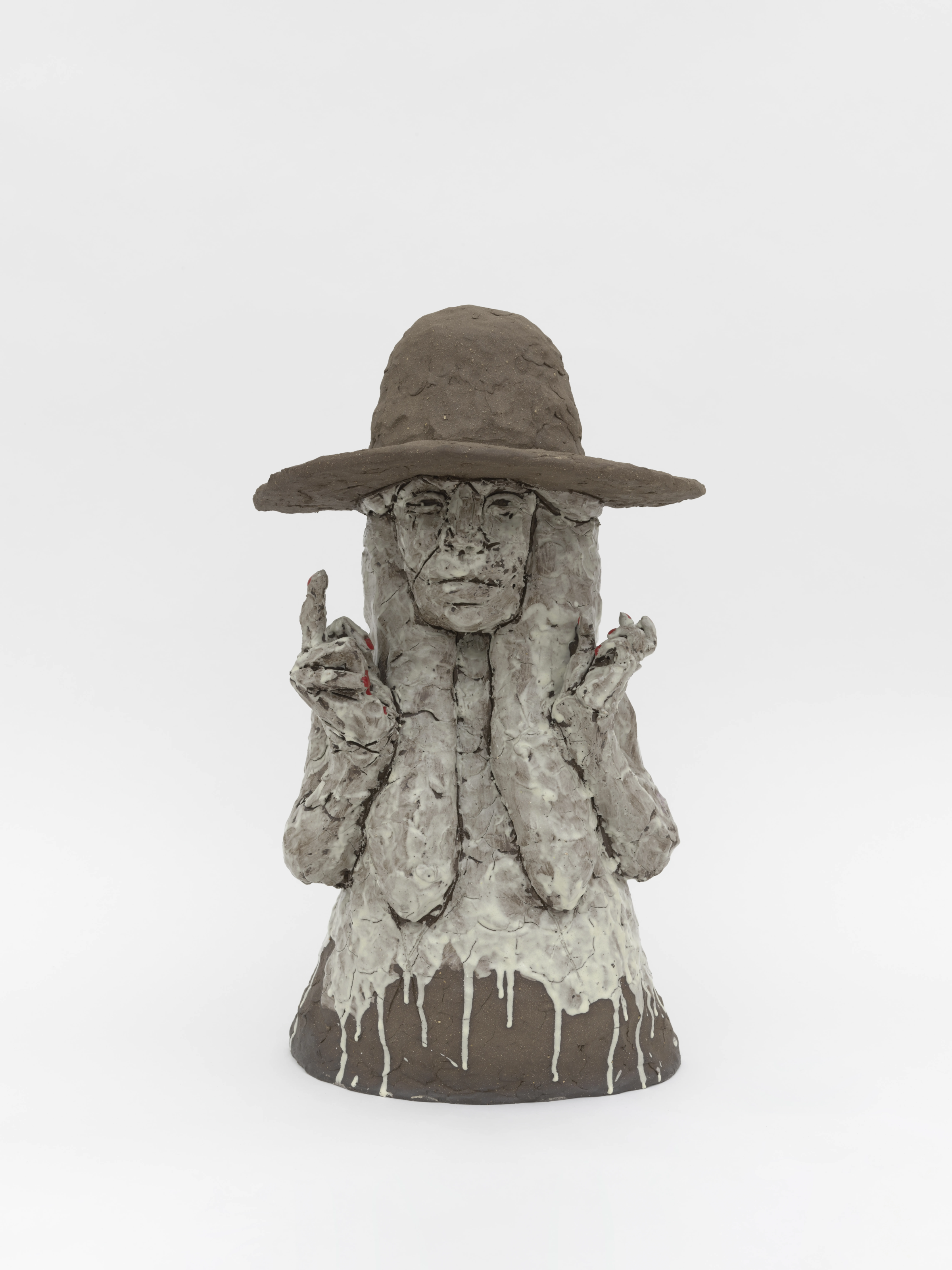
EB: What do you hope your work will offer people in the future?
RH: I want my future kids and grandkids to be able to see my work and think, ‘Oh look, there we are in history.’ I want to keep that place in history and continue to move forward with it.
GM: I just want the people I’ve learned so much from and love to be remembered in history in the highest way possible. I would love for my paintings to make someone feel like they belong and that they can do this too. It’s a practice of documenting someone’s power, and it’s a gift to observe and document that power, even if they don’t necessarily see it themselves.
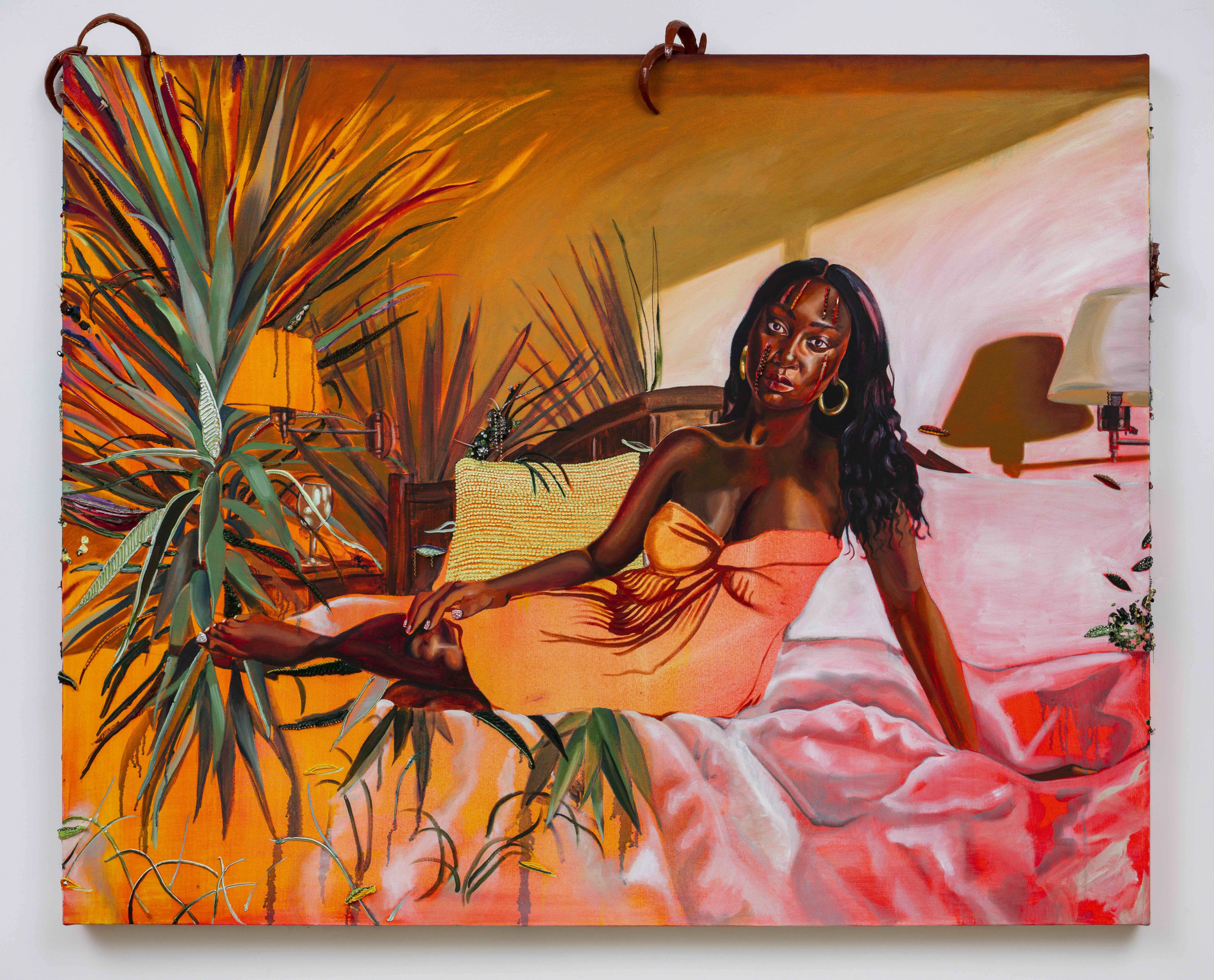
EB: Are there any books or texts that you would like to share with readers?
RH: I always have two books on the go—one is usually a bit heavier and nonfiction, while the other is super light. For culture and research, one of my go-to books is Caddo Indians: Where We Come From. It’s nice to balance that with the heavy research I do in my studio. Right now, I’m reading A Court of Thorns and Roses by Sarah J. Maas, which everyone calls ‘ACOTAR.’
GM: I’ve read that! I do the exact same thing—I like to listen to fantasy while I paint. There is one book I’d like to plug, written by my friend Julian, who is a human rights lawyer from Guam. It’s a really beautiful collection of essays about his childhood and life, and he has also successfully sued the U.S. military several times. The book is called No Country for Eight Spotted Butterflies by Julian Aguon.

EB: Do you have any self-care practices that ground you when you’re not creating art?
RH: I like writing in my journal a lot, which helps to ground me. I also like getting outside to walk my dogs; being outside is very meditative for me, just feeling the air on my skin. I also got some horses recently, which gets me outside even more. Spending time at the ranch where I ride my horses is top-tier self-care for me.
EB: What are their names?
RH: Jojo and Johnny Cash!
GM: I think my greatest tool of self-care is connecting to water. Ideally, it’s the ocean, but I love my bathtub too. I’ll put as much Epsom salt in it as possible and just lie there. I try to take good care of myself in general—I love reading, I love riding my bike, so I try to do more of those things. For me, it’s really about being intentional. I was listening to a meditation the other day, and it said something along the lines of ‘Think about each day of your life as your soulmate and get dressed accordingly.’ I’ve been thinking about that a lot. Even if I’m not going to see anyone, I make an effort to put myself together a little. When I take care of myself, I can be good to the people around me and to the work.
RH: Gisela, I want you to paint me!
GM: That would be amazing! I’ll send you the questions.
Words Emily Burke
